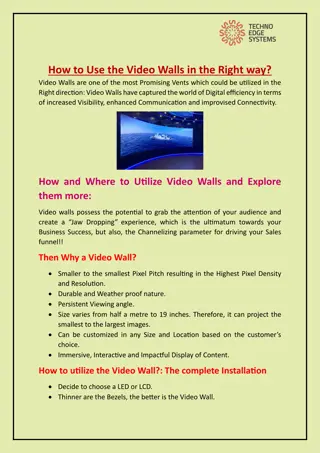Enhancing Agricultural Practices Through Video Conferencing and Webinars
Video conferencing and webinars offer valuable tools for the agricultural sector, enabling remote collaboration, knowledge sharing, training sessions, research collaboration, and policy discussions. Farmers can benefit from virtual consultations with experts, attend virtual training sessions, engage in farmer network meetings, and participate in interactive webinars, fostering community-building and knowledge exchange. These digital platforms provide cost-effective, convenient, and interactive ways to disseminate information and ideas, reaching a broader audience globally.
Download Presentation

Please find below an Image/Link to download the presentation.
The content on the website is provided AS IS for your information and personal use only. It may not be sold, licensed, or shared on other websites without obtaining consent from the author.If you encounter any issues during the download, it is possible that the publisher has removed the file from their server.
You are allowed to download the files provided on this website for personal or commercial use, subject to the condition that they are used lawfully. All files are the property of their respective owners.
The content on the website is provided AS IS for your information and personal use only. It may not be sold, licensed, or shared on other websites without obtaining consent from the author.
E N D
Presentation Transcript
Lecture 24: Video conference, live streaming and webinars Centurion University of Technology and Management, Odisha, India
Video conferencing can facilitate remote collaboration, knowledge sharing, and decision-making among farmers, agricultural experts, researchers, and other stakeholders. It allows individuals to connect, communicate, and conduct meetings virtually, regardless of their geographic locations. Remote Consultations: Farmers can have virtual consultations with agricultural experts or extension agents to seek advice, discuss challenges, and get recommendations for their farming practices. This saves time and travel costs while still benefiting from expert guidance. Training and Workshops: Agricultural organizations and institutions can conduct virtual training sessions, workshops, or webinars to educate farmers and stakeholders on various agricultural topics. Experts can deliver presentations, demonstrate techniques, and answer questions in real-time. Research Collaboration: Researchers working on agricultural projects can use video conferencing to collaborate, share findings, and discuss ongoing research. They can remotely communicate and exchange ideas, ensuring efficient collaboration and speeding up the research process. Centurion University of Technology and Management, Odisha, India
Farmer Network Meetings: Farmer groups, cooperatives, or associations can organize virtual meetings to discuss common challenges, share experiences, and collectively address issues. Video conferencing enables regular communication, fostering a sense of community and promoting knowledge exchange. Remote Monitoring and Advisory: By utilizing video conferencing alongside remote monitoring technologies, farmers can showcase their fields or livestock remotely to experts for assessment, diagnosis, and recommendations. Agricultural Extension Services: Extension agents can provide virtual extension services to farmers, delivering information on agricultural practices, pest and disease management, market trends, and government policies. This expands the reach of extension services to remote or underserved areas. Policy Discussions and Advocacy: Video conferencing enables stakeholders to participate in policy discussions, advocacy campaigns, and stakeholder meetings remotely. It allows farmers and agricultural organizations to voice their concerns, share insights, and contribute to policy development. Centurion University of Technology and Management, Odisha, India
Webinars Webinars are a great way to share information and ideas about agriculture with a large audience. They can be used to provide training, education, and networking opportunities for farmers, agricultural professionals, and other stakeholders. They can reach a large audience. Webinars can be accessed by people from all over the world, which means that you can reach a much larger audience than you could with a traditional in-person event. They are cost-effective. Webinars are a cost-effective way to share information and ideas, as you do not have to pay for travel or accommodation. They are convenient. Webinars can be attended from anywhere with an internet connection, which means that you can participate in a webinar from the comfort of your own home or office. They are interactive. Webinars can be interactive, which means that participants can ask questions and participate in discussions. This can help to ensure that participants get the most out of the webinar. Centurion University of Technology and Management, Odisha, India
Steps to Create Webinars Choose a topic that is relevant to your audience. Promote your webinar in advance. Make sure your webinar is well-organized and informative. Engage your audience with questions and discussions. Follow up with your audience after the webinar. Centurion University of Technology and Management, Odisha, India























